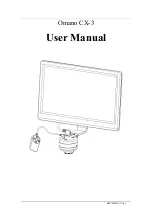
BARTINGTON INSTRUMENTS
Page 29 of 82 OM0408/49
7.2. Operating Instructions
Note:
Select a suitable site away from any possible sources of electromagnetic
interference.
Note:
Avoid situations where the sensor might be subject to large temperature fluctuations
or direct heating by the sun’s rays.
Switch on the instrument and allow ten minutes settling time before commencing
measurements.
7.2.1. Calibration Check
A calibration check core is provided. The serial number of the MS2C sensor appears on the
calibration core supplied. The value for the core, when used with the specified diameter sensor,
is printed around the middle of the core.
The stability of the sensor over time has been shown to exceed that of any core material which
might be used routinely to check the calibration. Therefore, the core should be used only to
identify when some catastrophic calibration error has occurred. If the sensor is within its factory
set calibration then the value obtained should be within 5% of the value printed on the core.
7.2.2. Calibration Notes
Appendix 2
provides calibration graphs that may be helpful when:
•
estimating true values of susceptibility (
c
vol
) for narrow strata
•
compensating for end of core effects
•
compensating for different core diameters.
When taking prolonged core logging sequences, a blank or ‘air’ value should be obtained before
and after logging. These values are used to obtain a base line correction when plotting the
results. Any drift can be assumed to have been linear up to 30 minutes.
















































